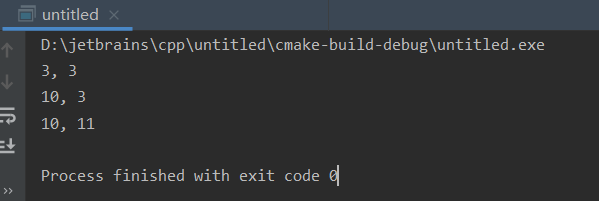可以通过“指针+偏移量”的方式访问私有变量。
#include <iostream>using namespace std;class Test{private:int a;int b;public:Test(int _a, int _b){a=_a; b=_b;}void Print(){cout << this->a << ", " << this->b << endl;}};int main() {Test a(3, 3);a.Print();int *p = (int*)&a;*p = 10;a.Print();*(p+1) = 11;a.Print();return 0;}
运行结果:
困惑:不同类型的成员变量的偏移量应该怎么计算
#include <iostream>using namespace std;class TestA{private:int a;int b;public:TestA(int _a, int _b){a=_a; b=_b;}void Print() const{cout << this->a << ", " << this->b << endl;}};class TestB{private:short a;int b;float c;double d;char e;public:TestB(short _a, int _b, float _c, double _d, char _e){a=_a; b=_b; c=_c; d=_d; e=_e;}void Print() const{cout << this->a << ", " << this->b << ", " << this->c << ", " << this->d << ", " << this->e << endl;}void PrintAddress() const {cout << &a << ", " << &b << ", " << &c << ", " << &d << ", " << &e << endl;}};int main() {TestA ta(3, 3);ta.Print();int* p = (int*)&ta;*p = 4;ta.Print();*(p+1) = 5;ta.Print();cout << "------------------" << endl;// 或者使用reinterpret_cast加字节偏移量char ch = 'e';TestB tb(13, 13, 13.0, 13.0, ch);cout << &tb <<endl;tb.PrintAddress();tb.Print();auto q1 = reinterpret_cast<short *>((char*)(&tb));*q1 = 14;tb.Print();auto q2 = reinterpret_cast<int *>((char*)(&tb) + 4);*q2 = 15;tb.Print();auto q3 = reinterpret_cast<float *>((char*)(&tb) + 2*4);*q3 = 16;tb.Print();auto q4 = reinterpret_cast<double *>((char*)(&tb) + 4*4);*q4 = 17;tb.Print();auto q5 = reinterpret_cast<char *>((char*)(&tb) + 6*4+1);*q5 = 'f';tb.Print();cout << sizeof(short*) << sizeof(int*) << sizeof(float*) << sizeof(double*) << sizeof(char*) << endl;cout << sizeof(short) << sizeof(int) << sizeof(float) << sizeof(double) << sizeof(char) << endl;return 0;}
运行结果:
D:\jetbrains\cpp\untitled\cmake-build-debug\untitled.exe3, 34, 34, 5------------------0x61fdc00x61fdc0, 0x61fdc4, 0x61fdc8, 0x61fdd0, e13, 13, 13, 13, e14, 13, 13, 13, e14, 15, 13, 13, e14, 15, 16, 13, e14, 15, 16, 17, e14, 15, 16, 17, e8888824481Process finished with exit code 0

